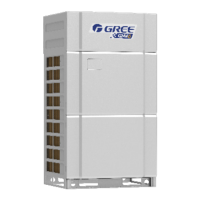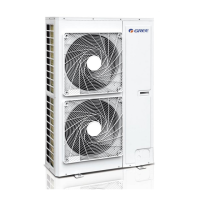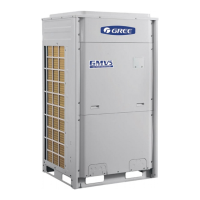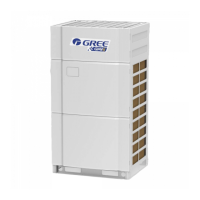
Do you have a question about the Gree GMV6 VRF and is the answer not in the manual?
| Category | Inverter |
|---|---|
| Inverter | Yes |
| Refrigerant | R410A |
| Type | VRF |
| Indoor Units | Connectable (wide variety of types and capacities) |
| Outdoor Unit | Single or multiple units depending on configuration |
| Energy Efficiency Ratio (EER) | Up to 4.0 |
| Control System | Centralized control, group control, individual control |
| Noise Level (Indoor Unit) | Varies depending on indoor unit type and capacity |
| Noise Level (Outdoor Unit) | Varies depending on outdoor unit capacity |
| Indoor Unit Dimensions (HxWxD) | Varies by model |
| Outdoor Unit Dimensions (HxWxD) | Varies by model |
| Indoor Unit Weight | Varies by model |
| Outdoor Unit Weight | Varies by model |
| Operating Temperature Range (Cooling) | -5°C to 48°C |
Lists the outdoor unit models available in the GMV6 DC Inverter VRF system, from 8HP to 88HP.
Details the advanced technologies and features of the Gree GMV6 DC inverter multi VRF system, including efficiency and reliability.
Describes how to adjust IDU and ODU capacity based on configuration ratios and temperature conditions.
Provides correction factors for cooling capacity based on ambient and indoor temperatures and configuration ratios.
Details the test method and points for measuring outdoor unit noise levels.
Shows outline dimensions and installation hole sizes for various GMV6 outdoor unit models.
Lists conditions and considerations for selecting a suitable installation location for the outdoor unit.
Illustrates required installation spaces (clearances) for ODU in different situations.
Provides guidelines for installing outdoor units considering seasonal wind conditions, with and without exhaust ducts.
Advises to consider snow accumulation when determining the installation base height for outdoor units.
Specifies requirements for installing outdoor units in equipment floors, including air exhaust ducts and louver angles.
Presents tables and diagrams for determining pipe sizes based on total capacity, length, and height differences.
Explains correct and incorrect piping methods for connecting multiple outdoor modules, including drop and length considerations.
Guides on selecting pipe sizes for different connection points (ODU to manifold, ODU modular branches, indoor branches).
Explains how to connect communication cords using screws to terminal boards.
Details the material standards and wiring methods for communication lines, including shielded wires and twisted pairs.
Describes serial connection for IDU and ODU communication cords, including matched resistance and avoiding specific IDU as master.
Introduces connection methods for communication cords between IDU and ODU, and between IDU and wired controllers.
Shows wiring diagrams for connecting single units and modular ODU/IDU systems.
Explains four connection ways between IDU and wired controllers, including setting master/deputy controllers.
Lists the quantities and types of external wiring interfaces for power supply, IDU/ODU communication, and central control.
Details external wiring requirements, including circuit breakers and system energization status.
Explains how to calculate pipeline charging amount based on liquid pipe length and diameter.
Provides tables for determining additional refrigerant quantity based on ODU capacity and IDU/ODU configuration rates.
Lists essential safety precautions for installation, handling, and operation to prevent damage and accidents.
Advises on refrigerant usage, including adherence to local regulations and maximum allowable concentration.











